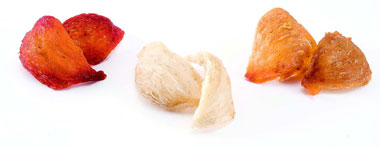|

|
|
These dried half-cup-like nests, yan wo, made of swiftlets' saliva, are translucent milky white or yellow, a few are deep red. They are top tonics for everyone and sell at high prices. They are usually made into soup.
|
Poor little birds spit out their nutrient-rich saliva to build translucent nests high on ocean cliffs. Then humans come along and wrest them away to prepare precious tonic. Bird's nests are big in China. The vast 258,000-square-meter Bird's Nest, or National Stadium, drew the world's applause at the Beijing Olympics last year. And tiny 6-centimeter-diameter bird's nests are big draws in a traditional Chinese medicine pharmacy.
Prominently displayed, these dried half-cup-like nests (yan wo) made of swiftlets' saliva, are translucent milky white or yellow, a few are deep red. Many are cushioned on satin and preserved under glass.
They are top tonics for everyone and sell at high prices. They are usually made into soup.
The half-moon nests are made of saliva strands that hardens. The swallow-type birds make their nests high on ocean cliffs, against the rock itself. Those who collect the nests climb high ladders or are suspended from cliffs - dangerous work that makes the nests even more expensive.
Depending on size, completeness (actually a matter of aesthetics), color (red is priciest) and packing, the nests can cost about 32-80 yuan (US$4.70-11.70) per gram. Bottled cooked nest weighing 200 grams cost from around 660-1,300 yuan.
One report says one kilogram can cost US$2,000, making bird's nest the "caviar of the East."
Bird's nests have long been a popular tonic especially for women, as they are said to improve the complexion by promoting cell regeneration and reduce signs of aging.
Medically, it is famous for reinforcing energy and relieving respiratory problems.
The saliva contains water-soluble protein, carbohydrates and micro-elements such as calcium, phosphorous, iron, sodium and potassium. It contains antioxidants and helps boost the immune system.
In terms of yin and yang energy, it is neutral.
Clearly this is not just any swift or sparrow's nest.
Swiftlets fly from Siberia to the tropics and sub-tropics for mating and nest-building. They are found in Vietnam, Thailand, Indonesia, Philippines and the southern coast of China. Indonesia exports most of the world's bird's nests.
It takes around 20 days to build a nest with saliva; it is thicker at the bottom and the wall is thin like a shell. It is usually 6-7 centimeters in diameter and weighs 10-15 grams.
The first nest that a swiftlet builds before egg-laying is of the top quality, as it is mostly pure saliva. These nests are called guan yan (official nests), and were given in tribute to emperors in the past.